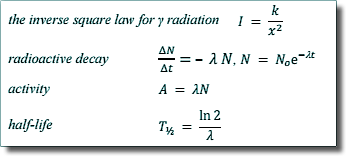Solutions: Radioactivity Questions
Q15.
(a) In a radioactivity experiment, background radiation is taken into account when taking corrected count rate readings in a laboratory.
One source of background radiation is the rocks on which the laboratory is built.
Give two other sources of background radiation.
Any TWO from: 
 the sun,
the sun,
 cosmic rays,
cosmic rays,
 radon (in atmosphere),
radon (in atmosphere),
 nuclear fallout (from previous weapon testing),
nuclear fallout (from previous weapon testing),
 any radioactive leak (may be given by name of incident)
any radioactive leak (may be given by name of incident)
 nuclear waste,
nuclear waste,
 carbon-14
carbon-14
(1 mark)
(b) A γ ray detector with a cross-sectional area of 1.5 × 10–3 m2 when facing the source is placed 0.18 m from the source. A corrected count rate of 0.62 counts s–1 is recorded.
(i) Assume the source emits γ rays uniformly in all directions.
Show that the ratio is about 4 × 10–3
The ratio of area of detector to the surface area of sphere = (1.5 × 10–3)/(4π x 0.182)
ratio = 1.5 × 10–3/0.407
= 3.7 x 10-3 which rounds to 4 × 10–3
which rounds to 4 × 10–3
(2 marks)
(ii) The γ ray detector detects 1 in 400 of the γ photons incident on the facing surface of the detector.
Calculate the activity of the source.
State an appropriate unit.
0.62 counts s–1 is recorded so 0.62 x 400 counts s–1 are incident on the detector.
The detector only intercepts 0.0037 of the gamma rays so the activity of the source is:
0.62 x 400/3.7 x 10-3 s–1
6.7 x 104  Bq or s–1
Bq or s–1 
(3 marks)
(c) Calculate the corrected count rate when the detector is moved 0.10 m further from the source.

I0.18 x 0.182 = I0.28 x 0.282
I0.28 = 0.62 counts s–1 x 0.182/0.282
I0.28 = 0.256 counts s–1
I0.28 = 0.26  counts s–1
counts s–1 
(3 marks)
(Total 9 marks)


